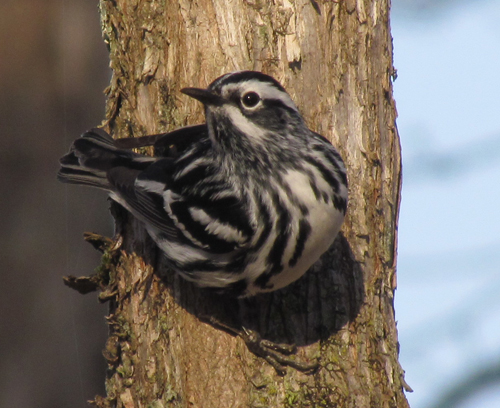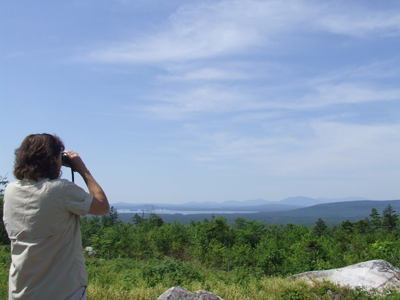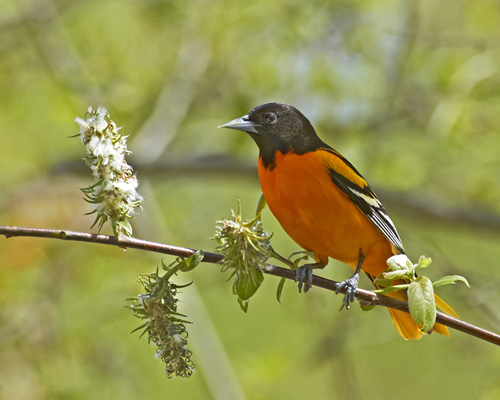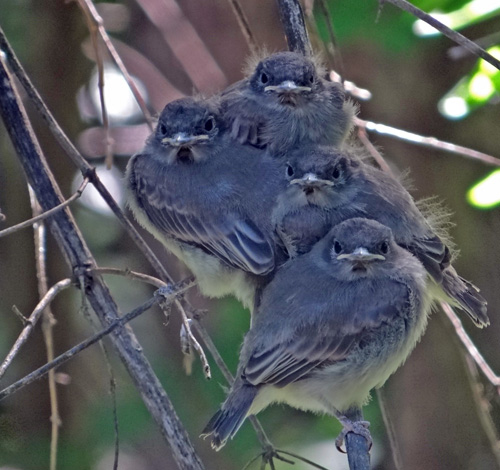Maine is famous for its tides, gently coming and going across mudflats and estuaries and pushing back and forth over the rocky coast. Those waters pour in from the Gulf of Maine and far out across the Atlantic—the same water that sweeps into Maine has probably touched the shores of Europe and other countries.

Black and White Warbler in Topsham. Photo by Jeff Wells.
But there’s another tide, one that would likely appear just as dramatic, if you could see it. It’s the great spring movement of North America’s migratory birds. It’s reaching its peak in the southern U.S. right now and will soon reach maximum flow for us here in Maine. If you could see this awesome phenomenon, it would take your breath away. But you won’t see it, because most birds migrate at night, and even if you stayed awake, the best you could do is find a quiet place to listen to the “zwirps” and “seeps” and “tsips” as they zip over your head in the darkness, calling to one another—proof to us humans of migration in progress. Set your scope up focused on the moon on a clear night and you might see a bird now and then passing in front of it. It’s a fascinating sight, but, as one birder has described it, a bit like watching a baseball game through a straw.

Bird watching on the proposed National Park Lands. Photo by Allison Wells.
Migration is far bigger than that. Think of what’s happening: every bird that spends the winter in South America (or the southern U.S., or the Caribbean) and breeds in Maine or beyond is making its way back to its breeding grounds. Millions and millions of birds: sparrows, tanagers, warblers, orioles, thrushes, grosbeaks, hummingbirds, rails, herons, the list goes on and on. Some species do migrate during the day—Turkey Vultures floating through the sky on teetering wings are among the first spring migrants to appear here in Maine, a welcome sign of what’s to come, and so are kettles of hawks curling up into the sky on the next big thermal. Mostly, though, the evidence becomes clear in the morning, when you delight that “your” bluebirds have returned to your nest box, and the orioles have “finally found” the orange wedges you’ve been putting out for them in the lilac tree over the last week or so. You see tail-wagging Palm Warblers and vibrant Yellow Warblers in the shrubbery, and the much-welcomed “Old Sam Peabody, Peabody, Peabody” whistle of the White-throated Sparrow echoing through the woods. The dawn chorus, silent for all those winter months, has finally returned, joined by an ever growing number of singers.

Oriole. Photo by NRCM member Pam Wells.
Few things in life are so expected yet continue to be such a surprise. No wonder that for more than 20 years, people have been celebrating the return of migratory birds each spring during International Migratory Bird Day. Hundreds of events will take place across the Americas this weekend, under the auspices of International Migratory Bird Day, including here in Maine.
Each year, International Migratory Bird Day has a different theme. This year’s is “Restore Habitat, Restore Birds,” focusing on the ways that bird habitats can be restored and protected so that there will always be places for birds to find food and shelter on their long migratory journeys. Habitat protection is essential for them to build their nest, too, and raise their young, and at stopover locations during their long flights back to their wintering areas, where habitat protection is also important.

Baby phoebes in Richmond. Photo by Beth Comeau.
The Natural Resources Council of Maine has been working incredibly hard at protecting Maine habitat for migratory birds and other wildlife. The issues we are working on right now—stopping bad mining rules that could poison Maine waters, pushing for increased solar energy and for reductions in climate-changing pollution, pressuring for protections for Maine’s Public Reserved Lands, and release of the Land for Maine’s Future bonds—all have huge habitat implications. It’s a great feeling to know that, because I work for NRCM, I’m helping to make the goals for this year’s International Migratory Bird Day a reality, and so are NRCM members who support this work.
As a bird enthusiast, I hope you will spend a little time outdoors this weekend, and take a moment to consider where the newly arrived migrants all around you have just come from, and how special the place is that so many of them are returning to now: Maine.











I enjoyed this article Learned a lot, and wonderful writing style.
Great post and photos!